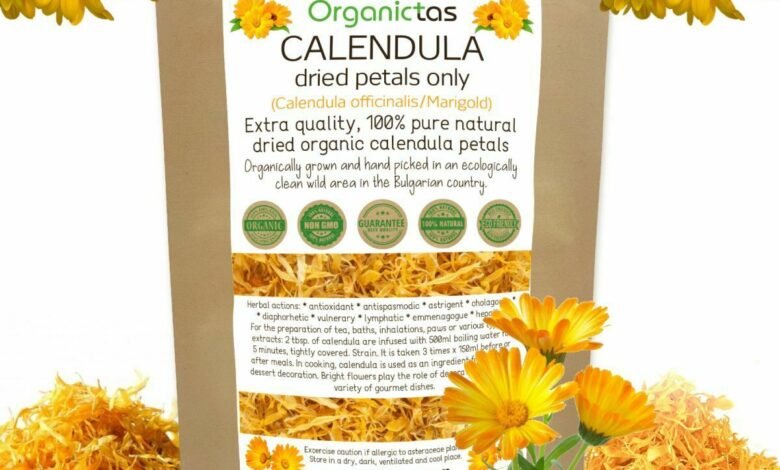Calendula Flower Benefits Uses and Complete Guide

The calendula flower (Calendula officinalis), often called marigold, is one of the most cherished plants in herbal medicine and natural skincare. With its bright orange or yellow blossoms, calendula not only adds beauty to gardens but also offers a wealth of therapeutic properties. From soothing skin irritations to boosting wound healing, calendula has been used for centuries in traditional remedies. In this comprehensive guide, we will explore the history, benefits, medicinal uses, skincare applications, and cultivation of calendula flower.
What is Calendula Flower?
calendula flower commonly known as calendula or pot marigold, is a flowering plant native to Southern Europe but now cultivated worldwide. It belongs to the Asteraceae family, which also includes daisies and sunflowers. The flower is not only admired for its ornamental value but also for its healing properties.
Calendula flower are edible and often used in teas, tinctures, salves, and even culinary dishes. Their bright yellow and orange petals are rich in antioxidants, flavonoids, and carotenoids, which give them their medicinal value.
History and Traditional Uses of Calendula
calendula flower has a rich history in both folk medicine and cultural traditions:
- In ancient Rome and Greece, calendula petals were used to decorate food and as herbal remedies.
- During the Middle Ages, calendula was believed to have magical properties and was often planted in cottage gardens.
- Traditional herbalists used calendula for wound healing, digestive health, and skin protection.
- Calendula was also called the “herb of the sun”, as its blooms open with sunlight and close at night.
Nutritional and Chemical Composition
calendula flower contains a variety of active compounds that make it a powerhouse in herbal medicine:
- Flavonoids – natural antioxidants that reduce inflammation.
- Carotenoids – including lutein and beta-carotene, which promote skin and eye health.
- Saponins – help in cleansing and stimulating the immune system.
- Essential oils – provide antimicrobial properties.
- Polysaccharides – known for immune-boosting effects.
These compounds explain why calendula is widely used in natural health remedies and skincare formulations.
Health Benefits of Calendula Flower
calendula flower offers multiple benefits for both internal and external health. Let’s look at its most well-known medicinal properties:
- 1. Skin Healing and Wound Care
Calendula is best known for its ability to speed up wound healing. Studies have shown that calendula ointments can help close wounds faster, reduce swelling, and minimize scarring. It is commonly used in:
- Minor cuts and scrapes
- Burns and sunburns
- Insect bites and stings
- Post-surgical wounds
- 2. Anti-Inflammatory Properties
Calendula’s flavonoids help reduce redness, swelling, and irritation. This makes it highly effective for treating:
- Eczema
- Dermatitis
- Psoriasis
- Diaper rash
- 3. Antimicrobial and Antifungal Effects
Calendula extracts have antibacterial and antifungal properties, making them useful for preventing infections. Calendula tea or diluted tinctures may be used as a natural mouthwash for gum infections or sore throats.
- 4. Digestive Health
Calendula tea has traditionally been used to soothe stomach ulcers, gastritis, and indigestion. Its mild antispasmodic effects can reduce cramping and discomfort.
- 5. Immune Support
Thanks to its antioxidants and polysaccharides, calendula may help strengthen the immune system, making the body more resistant to infections.
- 6. Menstrual Relief
Calendula has been used historically to regulate menstrual cycles and ease cramps due to its mild hormonal effects.
- 7. Eye Health
The lutein and carotenoids in calendula support healthy vision and protect the eyes from oxidative stress and blue light damage.
Calendula in Skincare
Calendula is one of the most popular natural ingredients in cosmetics and skincare. Its soothing, hydrating, and healing properties make it suitable for sensitive skin. Common calendula skincare products include:
- Calendula oil – infused oil used for massage, skin hydration, and irritation relief.
- Calendula cream or salve – applied to cuts, burns, eczema, and insect bites.
- Calendula face wash and toner – helps reduce acne and redness.
- Calendula baby products – used in diaper rash creams and gentle soaps.
Dermatologists often recommend calendula-based creams for people with sensitive or allergy-prone skin.

How to Use Calendula
Calendula can be used in various forms, depending on the purpose:
1. Calendula Tea
Made by steeping dried calendula petals in hot water. It can be consumed for digestive issues or used as a soothing rinse for sore throats.
2. Calendula Oil
Infusing dried petals in a carrier oil (such as olive or jojoba oil) produces calendula oil, which can be applied to skin irritations and dryness.
3. Calendula Tincture
A concentrated extract often used for wound cleansing, diluted before use.
4. Calendula Ointments and Creams
Widely available in pharmacies and natural health stores for wound care and skin conditions.
5. Culinary Uses
Fresh or dried calendula petals can be added to salads, soups, rice, and baked goods as a colorful and nutritious garnish. It is sometimes called “poor man’s saffron” due to its ability to add color to dishes.
Growing Calendula at Home
Calendula is easy to grow, making it a favorite among herbal gardeners. Here are some tips:
- Soil: Prefers well-drained soil, rich in organic matter.
- Sunlight: Thrives in full sun but tolerates partial shade.
- Watering: Requires moderate watering; avoid overwatering.
- Harvesting: Flowers should be picked when fully open, ideally in the morning after dew has dried.
- Preservation: Dry petals in a cool, dark place to store for tea, oil, or skincare use.
Calendula flower are not only medicinal but also attract beneficial insects like bees and ladybugs to your garden.
Possible Side Effects and Precautions
Calendula is generally safe for most people, but a few precautions should be noted:
- People allergic to plants in the Asteraceae family (daisies, ragweed, chrysanthemums) may experience allergic reactions.
- Pregnant or breastfeeding women should consult a doctor before using calendula internally.
- Calendula tinctures contain alcohol, which may not be suitable for children.
Conclusion
The calendula flower is far more than a bright garden plant—it is a natural remedy with healing, soothing, and protective qualities. From skincare to digestive health, calendula continues to prove why it has been cherished in herbal medicine for centuries. Whether you choose to drink it as a tea, apply it as a cream, or grow it in your garden, calendula remains a gentle yet powerful plant ally for natural wellness.
